
Original Link: https://www.anandtech.com/show/1937
Introduction
While the industry has definitely firmly attached itself to PCI Express, many enthusiasts out there are still running AGP based systems. The cost of keeping up with the pace of technology is certainly steep, so upgrade cycles for some people stretch quite a bit longer than others. Even in cases where a technophile is able to upgrade frequently, no savvy user would just throw out last year's top of the line. If that AGP box doesn't become a hand-me-down to a friend or relative, keeping an older system around for some LAN gaming when guests come to visit is definitely a nice alternative to the trash heap.
Whatever the situation, there are plenty of people out there looking to extend the life of AGP systems in one way or another. And if gaming is a primary function of the computer, graphics card upgrades are most often the way to go for users who want the most bang for the buck. Luckily, NVIDIA hasn't left the users behind. Today, the GeForce 7800 GS makes its debut as NVIDIA's first AGP 7 Series product.
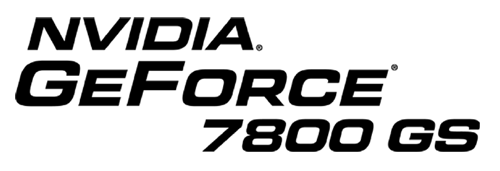
Some of you may remember that we took a look at a PCI Express 7800 GS (which will never exist) when an NVIDIA partner accidentally gave away an engineering sample instead of a 7800 GT in a promotion. The specifications of the AGP 7800 GS are not very far off the part that we tested a few months back, but on the AGP platform, there is considerably less competition at the top. Add to this the fact that some manufacturers are shipping boards with higher than stock core and memory speeds, and this part could definitely push an AGP system as far as it is likely to go.
Between a Rock and a Hard Launch
In the wake of the recent, very successful hard launch of the X1900 series by ATI, NVIDIA has had quite a bit of pressure placed on them to make up for the stumbles that they have had with 7800 GTX 512 availability and the limited regional availability of the 7300 series at launch. We have certainly been putting a lot of pressure on these companies to deliver tangible product on the day of a launch. Doing so helps reviewers and consumers alike. We are able to report on a product that we know exists, and we are better able to make a solid recommendation about what to buy. Those interested in the cards don't have to wait for some far off date in the future to get their hands on hardware. Hard launches are a good thing and we want to keep seeing them happen.
And, as is usually the case, we would love to see even more: more parts, more stores with parts, and more countries included at launch. But these kinds of things tend to get a little complicated, and sometimes we end up in situations like what we see today.
We have full retail boxes from both BFG and EVGA. NVIDIA is calling this a hard launch, and we know that they have product out there. Only, no one can buy it until Sunday and Monday. The reason for this is that Best Buy is working with NVIDIA on this launch, and they will start selling their stock on Sunday. NVIDIA has informed us that Friday, Saturday, and Sunday are poor days to launch new products, and in order to get the word out before Best Buy started selling cards, the most logical choice is to launch today. Right?
So, we are left with an odd situation where NVIDIA is launching a product that will be available in a brick and mortar store before it is available online, but without immediate availability at launch. This time, we're asking what you think. Is this a good thing? Certainly, getting parts out to physical locations anywhere near a launch is a great thing, but what do we need to see from a company in order to call something a hard launch?
This time around, we will adopt a wait-and-see attitude. We will base future reaction to and analysis of launches like this on what actually happens with this launch (when we go to Best Buy Sunday, there had better be some parts on the shelf) and the feedback that we get from our readers. The power is in your hands; let us know what you think in the comments.
UPDATE: We stand corrected. It has been brought to our attention that CompUSA has 7800 GS boards and is selling them. With that, we are quite impressed with the level of hardness that NVIDIA has brought forth: it's right off the end of the Mohs' scale.
The Card and The Test
As mentioned, we currently have both a 7800 GS from EVGA and the 7800 GS OC from BFG. Neither of these cards run at the default 375/1.2 clock speeds set forth by NVIDIA. For the purposes of these tests, we underclocked a card to the minimum speed that NVIDIA is endorsing. With the high clock speeds that we see from BFG and EVGA, we'd be willing to bet that even 7800 GS parts that don't come factory overclocked would have some head room. The EVGA card is clocked at core/mem clocks of 460/1.35, while the BFG part runs at 400/1.25. It is interesting to note that the BFG part makes a bigger deal out of being overclocked on the box than the EVGA card, but either way, the 7800 GS is no slouch.
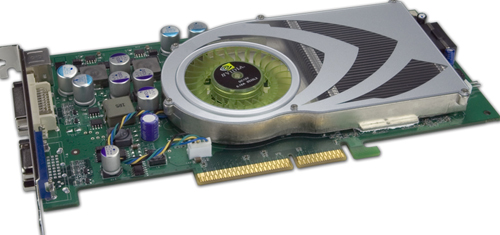
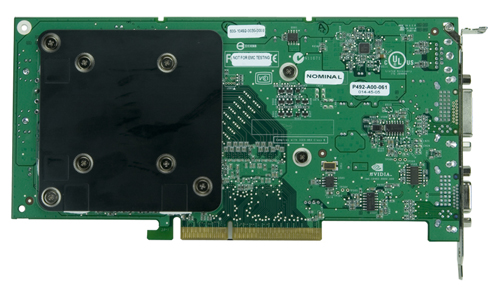
Gigabyte K8U-939 ULi based motherboard
AMD Athlon 64 FX-57
2x 1GB OCZ PC4000 RAM @ 200MHz 2:3:3:8
160GB Seagate 7200.7 HD
OCZ 600W PowerStream PSU
For reference, we have included the 7800 GTX 512 and the X1900 XTX. This gives us a clear look at the highest end ATI and NVIDIA hardware available for both the AGP and PCIe platforms. The 7800 GT is also included in order to show us the performance of the next fastest NVIDIA part out there.
Here's a breakdown of the 7800 GS specifications as outlined by NVIDIA.
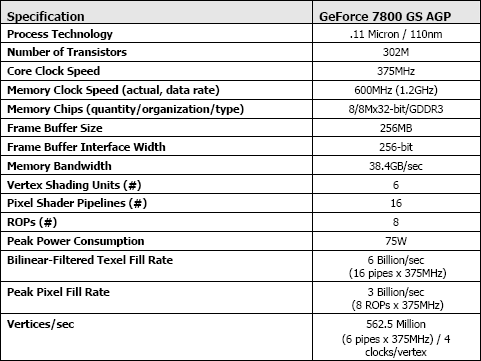
Battlefield 2 Performance
The performance of the 7800 GS AGP is very strong in Battlefield 2. This is the one game where the X850 XT PE truly falls behind the new AGP 7 series part. NVIDIA's lead is not a big one in this game, but it's there, and that's definitely a good thing for a cheaper part.
Clearly, the PCIe cards dominate our AGP lineup. The bottom line is that the bleeding edge in performance is simply not available on older platforms. Cards like the X850 XT PE, and now the 7800 GS are the best an AGP user is going to do.
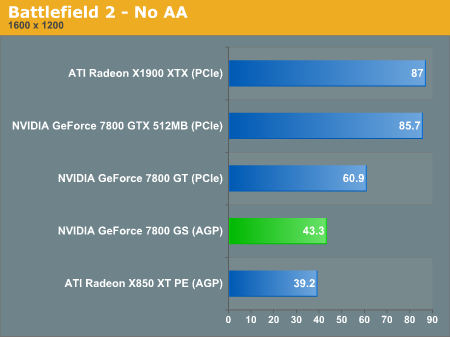
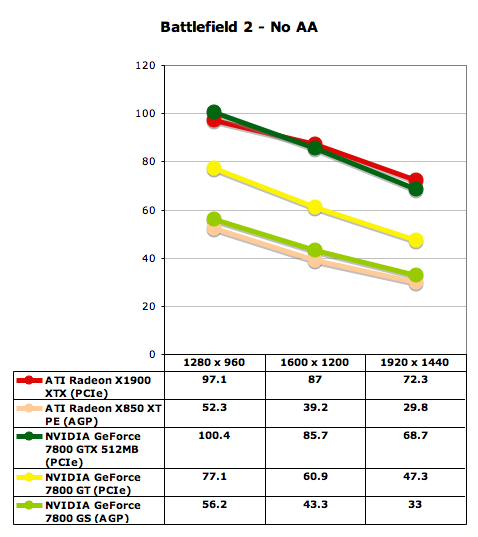
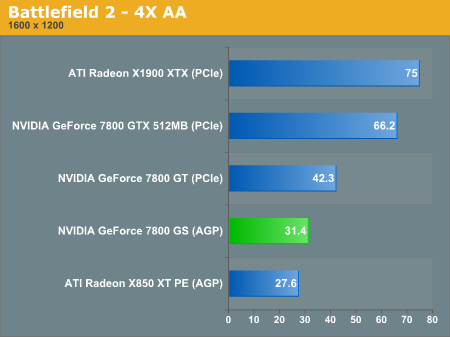
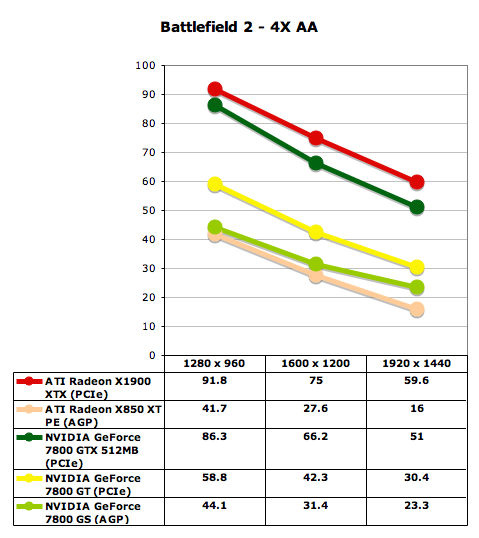
Far Cry Performance
The 7800 GS clearly falls behind in FarCry. The X850 XT PE just has more to offer here. Interestingly, the X850 XT PE has an increased lead in our AA tests until we push above 1600x1200. While neither the X850 nor the 7800 GS is really playable at 1920x1440, it is interesting to see that the NVIDIA part drops more gracefully in performance here.
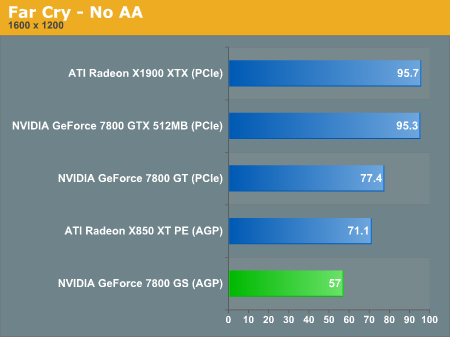
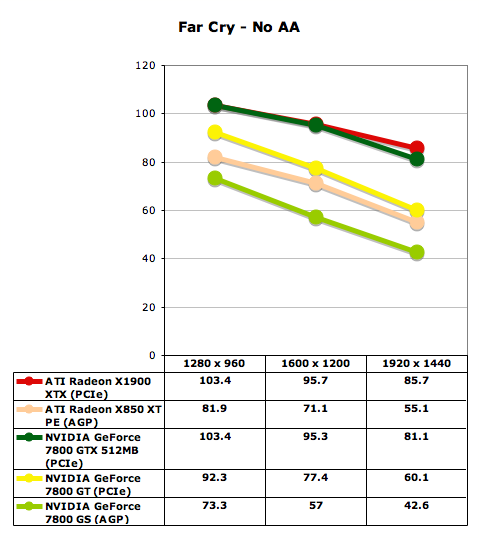
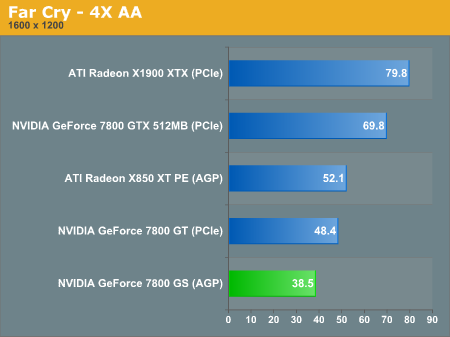
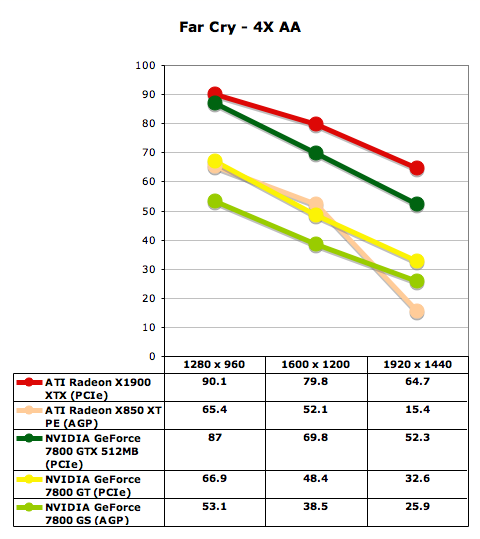
F.E.A.R. Performance
The X850 XT PE definitely dominates the 7800 GS in F.E.A.R. The only resolutions at which the 7800 GS is playable under F.E.A.R. are below 1600x1200 with no AA. If AA is a necessary enahncement for your gaming pleasure, some of the eye candy can be disabled to boost the frame rate, but a low resolution is still in order.
This game does pack quite a visual punch, but the performance needed to keep pace is quite steep. We test with soft shadows off and all other settings on maximum.
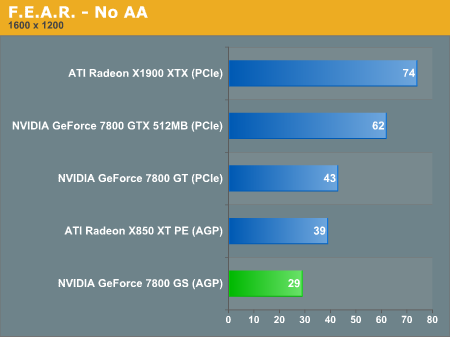
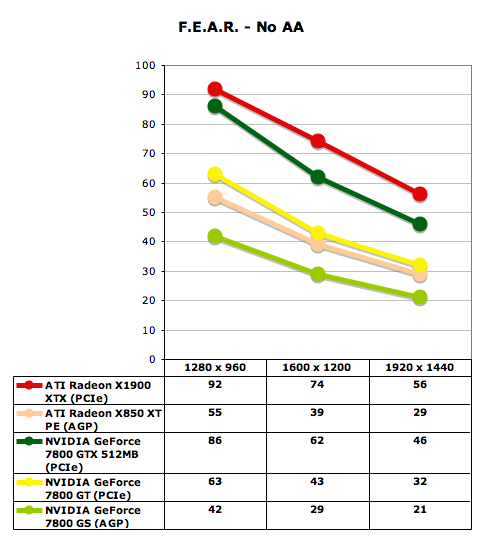
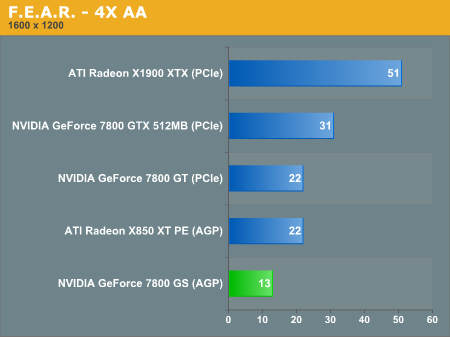
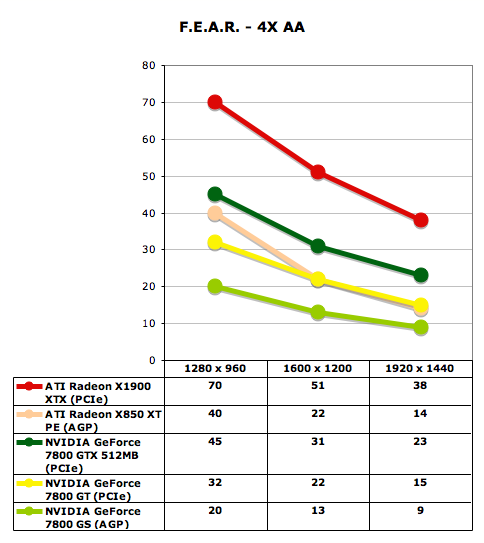
Quake 4 Performance
The X850 XT PE and the 7800 GS perform all but the same under Quake 4. This implys that other Doom 3 powered games will also exhibit the same characteristics. Both these cards are playable at 1920x1440 without AA and 1600x1200 with 4xAA enabled. This results in quite an enjoyable Quake 4 experience.
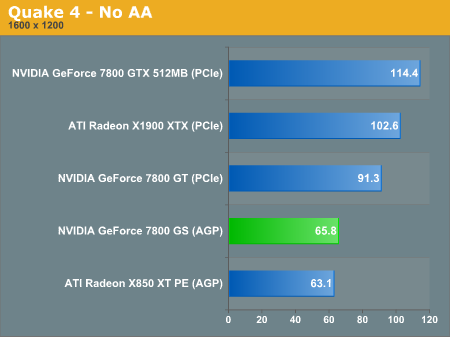
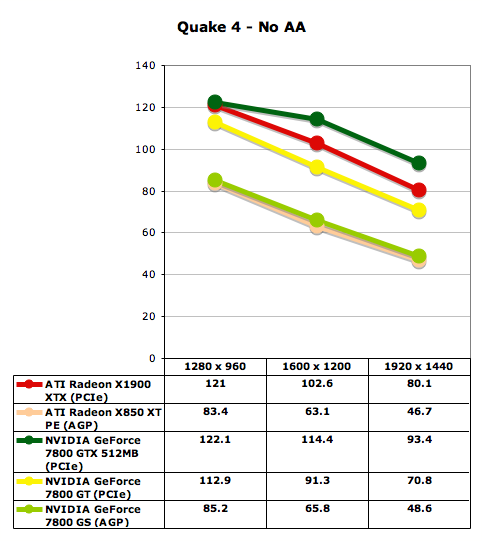
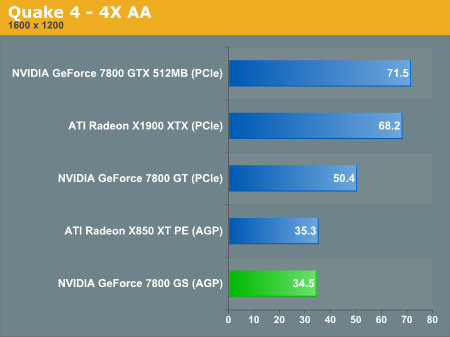
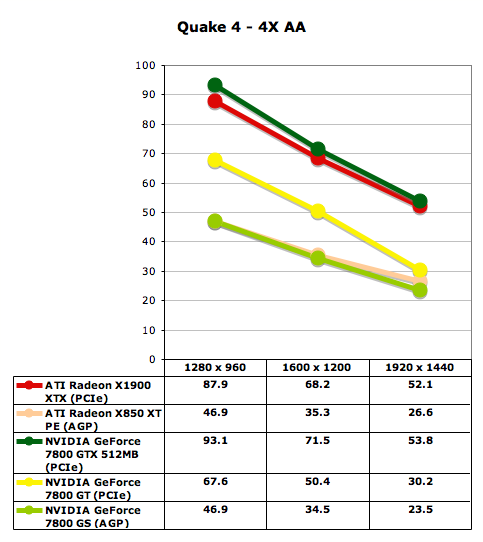
Splinter Cell: Chaos Theory Performance
If there's only one benchmark you read about, let it be this one. Our 7800 GS was tested with SM3.0 enabled and all the options while the X850 XT PE does not support these features.
The price the 7800 GS pays for enabling HDR and other SM3.0 eye candy is that it is limited in playability to lower resolutions. Disabling the SM3.0 features would give performance quite a boost without AA (SM3.0 features are not available with AA enabled).
This indicates that the X850 XT PE performs better with AA under SC3 than the 7800 GS. But the performance numbers that we ran can't be easily compared without AA. We wanted to look at performance with the features that people would likely enable, and Splinter Cell certainly looks great with all the bells and whistles.
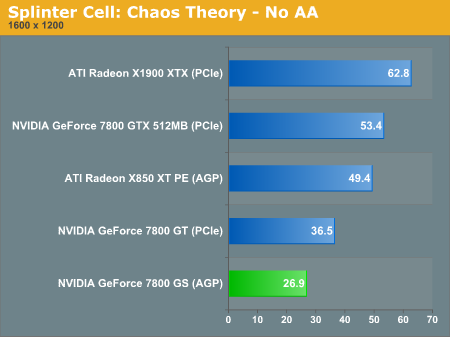
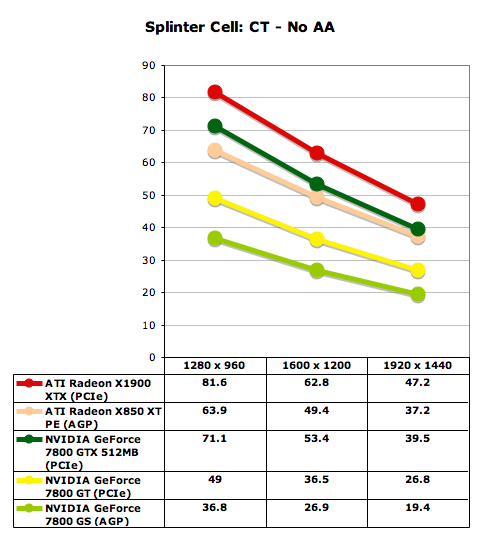
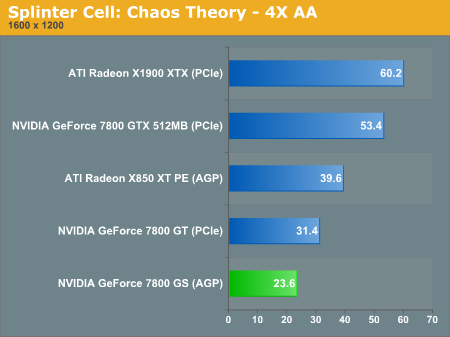
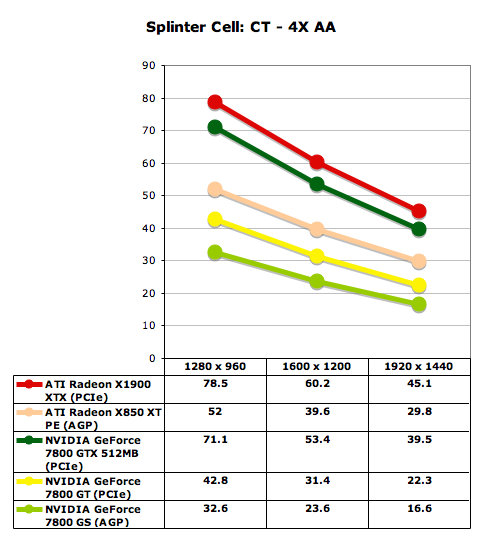
Final Words
With the Radeon X850 XTPE holding the top spot on AGP hardware up until now, NVIDIA hasn't had a solid high performance AGP showing since the power hungry 6800 Ultra. With prices on the aging, high-end 6 series parts absurdly high, it is quite nice to see an AGP 7 series part show up with good performance, lower power requirements, better features and a friendlier price tag, at about $300. Even though the X850 XTPE is generally faster than the new NVIDIA part, the price tag is a little steeper as well, at about $400. This leaves ATI holding onto a claim for the fastest AGP solution out there, but the feature set of the 7 series part is a bit more refined than that of the venerable X850.
Along with high performance (for an AGP system), the 7800 GS brings a more efficient architecture to the platform. With the math revisions and added features of the 7 series, per clock and per watt performance is increased over the 6 series parts. Transparency AA might not be very performance-friendly on newer games, but older titles and CPU limited games will certainly benefit from enabling it. Other features, like SM3.0, are also an advantage, as most of the ATI AGP hardware still doesn't support this. It remains to be seen what ATI will do in response to this move by NVIDIA, but the fact that there are AGP versions of the X1600 available indicates that ATI hasn't completely pulled out of the platform yet.
We aren't quite sure how to call the availability aspect of this launch quite yet, and we await your input on the subject. Certainly, the ideal situation is for everything to happen at exactly the same time, around the world for every launch, but there are limits to what is possible. On the one hand, NVIDIA has arranged for their launch to include hardware in brick and mortar rather than just online, but on the other hand, we can't buy it today. Please let us know what is important to you, as I'm sure NVIDIA are interested as well.
For now, we can certainly conclude that the 7800 GS is a worthy AGP part. We will take a further look into performance with the BFG and EVGA versions of the 7800 GS if there is any interest.







